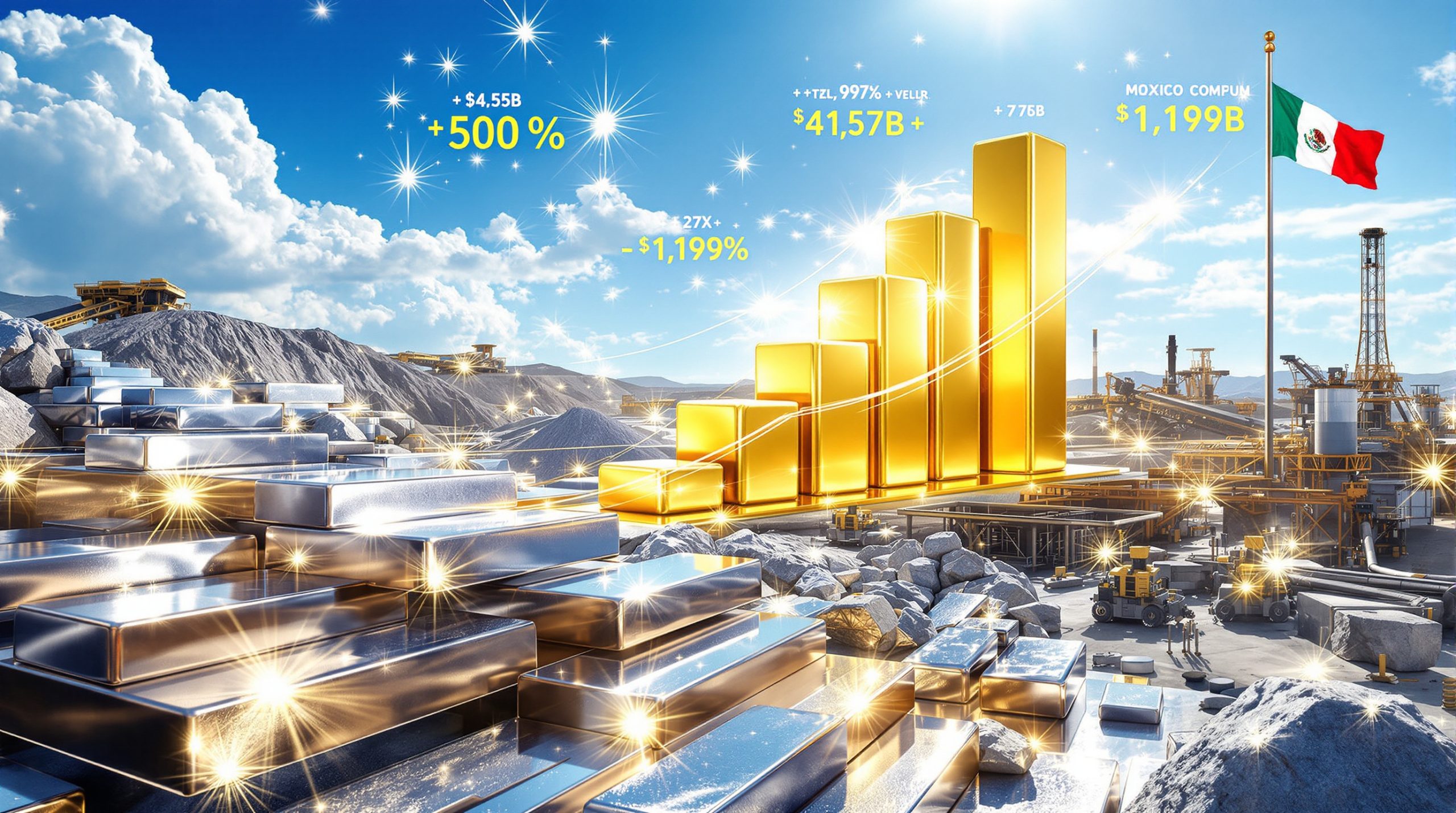Goldman and UBS Bullish on Gold Prices: Expert Forecasts for 2025-2026
Major investment banks Goldman Sachs and UBS have released strikingly optimistic gold price forecasts for 2025-2026, pointing to a potential surge that could see the precious metal reach unprecedented heights. These bullish projections have captured the attention of investors globally as gold continues to demonstrate remarkable resilience amid economic uncertainties.
The forecasts from these financial powerhouses suggest gold's multi-year uptrend remains firmly intact, with specific price targets that would represent significant gains from current levels. This bullish outlook comes as central banks worldwide continue their aggressive purchasing strategies, fundamentally altering the supply-demand dynamics in the gold market analysis.
What Are the Latest Gold Price Forecasts from Major Banks?
The financial world took notice when two of the most respected investment banks released their gold price targets for the coming years, with both institutions projecting substantial upside potential.
Goldman Sachs Projections
Goldman Sachs has established itself as one of the most bullish voices on gold, with their latest forecast projecting prices to reach $3,700 per ounce by the end of 2025. This ambitious target is complemented by an even more striking prediction of $4,000 per ounce by mid-2026, representing a potential increase of over 25% from current levels.
The analysis team, led by veteran commodities analyst Lina Thomas, emphasized that these projections are based on comprehensive supply-demand modeling that incorporates macroeconomic variables, central bank purchasing patterns, and geopolitical risk premiums. "When we examine the structural drivers behind gold's momentum, we see a confluence of factors that support a continued uptrend through 2026," Thomas noted in Goldman's latest commodities outlook.
UBS Group Outlook
While slightly less aggressive than Goldman's forecast, UBS Group has also presented a decidedly optimistic outlook for gold price trends 2024. The Swiss banking giant projects gold will reach $3,500 per ounce by December 2025, according to a strategic investment note published in April 2025.
UBS strategist Joni Teves, widely respected for her metals analysis, cited "unprecedented central bank accumulation patterns" as a primary driver behind their bullish stance. "Central banks added over 1,200 tonnes to their reserves in 2024 alone, continuing a trend that fundamentally alters the market's traditional supply-demand balance," Teves explained.
Why Are Major Investment Banks Bullish on Gold?
The convergence of bullish forecasts from leading financial institutions isn't coincidental. Several structural factors have emerged that support higher gold prices over the medium term.
Central Bank Demand Exceeding Expectations
Perhaps the most significant driver behind banks' optimistic outlook is the stronger-than-anticipated purchasing patterns from global central banks. Annual central bank gold acquisitions have consistently exceeded analysts' projections for three consecutive years, with diversification away from traditional reserve currencies accelerating at a pace not seen since the 1970s.
Russia and China have led this trend, but smaller economies from Southeast Asia to South America have also joined the gold-buying spree. This institutional accumulation has created sustained buying pressure that absorbs a significant portion of annual mine production.
What's particularly notable is the strategic nature of these purchases. Central banks are no longer viewing gold as a legacy holding but as an active diversification tool against dollar dependency. With foreign exchange reserves growing globally, even a small percentage reallocation toward gold creates substantial demand.
Gold's Role as a Safe-Haven Asset
The second pillar supporting banks' bullish outlook is gold's increasingly important function as a hedge against recession risks. As economic uncertainties persist across major economies, institutional investors have dramatically increased their gold as safe-haven asset allocations.
Gold's negative correlation with risk assets during market stress events has strengthened in recent years. During the first quarter of 2025, when equity markets experienced volatility exceeding 18%, gold demonstrated remarkable stability with volatility of just 12%.
This demonstrated resilience during market turbulence has reinforced gold's safe-haven reputation. Furthermore, geopolitical tensions across multiple regions have added a risk premium to gold prices that analysts believe will persist through 2026.
What Factors Are Driving Gold's Price Momentum?
The positive outlook for gold extends beyond central bank buying and safe-haven demand. Several macroeconomic and geopolitical considerations suggest continued strength in the precious metals sector.
Macroeconomic Considerations
The monetary policy landscape represents a critical factor in gold's price trajectory. While central banks initially signaled tightening cycles, persistent inflation pressures have complicated their path forward. With global inflation rates averaging 5.2% in early 2025, real interest rates remain negative in many economies despite nominal rate increases.
This negative real rate environment has historically provided a tailwind for gold prices. Additionally, concerns about fiscal sustainability in major economies have intensified, with government debt-to-GDP ratios reaching record levels. These twin pressures create what Goldman's Thomas describes as "the perfect macroeconomic backdrop for gold appreciation."
Gold's traditional role as an inflation hedge has also regained prominence. After years of dormant inflation, the post-pandemic surge in prices has reminded investors of gold's historical performance during inflationary periods. Portfolio managers increasingly view gold exposure as essential rather than optional in this environment.
Geopolitical Risk Premium
Escalating global tensions have added another dimension to gold's appeal. The geopolitical risk index reached 158 in Q1 2025, significantly above the historical average of 100, reflecting heightened uncertainty across multiple regions.
Regional conflicts have created investment uncertainty that benefits gold's status as the ultimate "stateless currency." From tensions in Eastern Europe to territorial disputes in Asia, the global political landscape has become increasingly unstable, pushing institutional investors toward hard assets with no counterparty risk.
This diversification benefit during political instability has historically supported gold prices during similar periods of elevated geopolitical tension. The current environment appears particularly conducive to maintaining this risk premium through the forecast period.
How Do Current Gold Prices Compare to Historical Levels?
While nominal gold prices have reached record highs, context is crucial for understanding gold's potential trajectory from current levels.
Price Performance Analysis
Gold has delivered impressive year-to-date gains of 22% in 2025, outperforming major equity indices including the S&P 500's 15% return over the same period. This momentum has been accompanied by improving technical indicators, with gold maintaining price levels above all major moving averages.
The current gold bull market shares several characteristics with previous significant uptrends, particularly the 2008-2011 rally that saw prices more than double. However, analysts note that the current advance features stronger fundamental support through central bank buying compared to previous cycles that relied more heavily on investment demand.
From a technical perspective, gold has established solid support levels that should limit downside risk. Chart patterns suggest consolidation phases have created platforms for subsequent price advances, with each new high followed by higher lows during corrective phases.
Historical Context for $4,000 Gold
Goldman's $4,000 target would represent a new all-time high in both nominal and inflation-adjusted terms. The previous inflation-adjusted peak from January 1980 translates to approximately $3,200 in today's dollars, meaning Goldman's forecast envisions gold exceeding even its greatest historical valuation.
To reach Goldman's mid-2026 target from current levels would require approximately a 30% price increase over 18 months. While substantial, this pace of appreciation is actually moderate compared to historical gold bull markets, which have often seen price increases exceeding 50% within similar timeframes.
When examining gold prices relative to monetary aggregates or global financial assets, current valuations remain below previous cyclical peaks. This suggests that despite nominal price records, gold may not be overvalued in relative terms.
What Are the Investment Implications of Higher Gold Prices?
For investors, the forecasted gold price trajectory creates both opportunities and strategic considerations across multiple asset classes.
Portfolio Allocation Strategies
Financial advisors have increasingly recommended gold exposure of 5-10% in diversified portfolios, up from traditional allocations of 3-5%. This shift reflects gold's improved risk-adjusted return profile in the current macroeconomic environment.
The diversification benefits of gold have become more pronounced, with its correlation to equities turning more negative during market stress periods. This "crisis alpha" characteristic makes gold particularly valuable in the late stages of economic cycles, where many analysts believe we currently stand.
For investors implementing these allocation recommendations, the expected risk-adjusted returns at different price points remain attractive. Even at $3,500 per ounce, gold's Sharpe ratio projections compare favorably to most equity markets, according to UBS models.
Gold Mining Equities Outlook
Perhaps the most compelling opportunity lies in gold mining equities, which historically provide operational leverage to rising gold prices. With average all-in sustaining costs (AISC) for major producers around $1,200 per ounce in 2025, the profit margin expansion at Goldman's target prices would be substantial.
Mining companies have demonstrated remarkable capital discipline following previous boom-bust cycles, with many major producers prioritizing free cash flow and shareholder returns over production growth at any cost. This focus on profitability rather than volume has positioned the sector to potentially deliver superior returns in a rising gold price environment.
Beyond established producers, the economics of exploration and development projects improve dramatically at higher gold prices. Projects with break-even costs of $2,000-2,500 that were marginally economic become highly attractive at $3,500+ gold, potentially triggering a new wave of mine development after years of underinvestment in the sector.
FAQ: Gold Price Forecasts and Investment Considerations
What is driving the bullish outlook for gold prices?
The positive outlook is primarily driven by three factors: exceptional central bank demand that has exceeded analysts' expectations for three consecutive years, gold's strengthened role as a recession hedge amid persistent economic uncertainties, and heightened geopolitical tensions creating a risk premium. The combination of these factors has created what Goldman Sachs raises gold price 2025 describes as a "structural bull market" in gold that could extend through 2026.
When do analysts expect gold to reach $4,000 per ounce?
Goldman Sachs specifically projects gold to reach $4,000 per ounce by mid-2026, representing their most optimistic timeline. This forecast assumes continued central bank buying and no resolution to current geopolitical tensions that support gold's risk premium.
How do Goldman Sachs and UBS forecasts compare?
While both banks maintain decidedly bullish stances, their specific targets differ somewhat. Goldman Sachs projects $3,700 by end-2025 and $4,000 by mid-2026, while UBS forecasts $3,500 by December 2025. The approximately $200 difference in their 2025 year-end targets reflects slightly different assumptions about the pace of central bank accumulation and monetary policy trajectories.
What role does gold play in a diversified investment portfolio?
Gold serves multiple functions in a diversified portfolio: as a hedge against inflation and currency devaluation, a safe-haven during market volatility, and a non-correlated asset that can improve overall portfolio efficiency. Financial advisors have increased recommended allocations to 5-10% of portfolios, reflecting gold's enhanced strategic importance in the current macroeconomic environment.
How might central bank policies impact gold prices?
Central bank policies influence gold prices through multiple channels. Monetary policy decisions, particularly regarding interest rates, directly impact gold's opportunity cost since gold produces no yield. The current environment of negative real interest rates (nominal rates below inflation) has historically supported gold prices. Additionally, central bank reserve diversification strategies that favor gold acquisition create direct buying pressure that supports prices. Should these trends continue as Goldman and UBS project, they would provide a fundamental foundation for higher gold market outlook 2025 through 2026.
For investors looking to capitalize on this positive outlook, exploring various Gold ETFs strategies may provide an accessible entry point to gain exposure to the anticipated price movements without the complexities of physical ownership.
Want to Spot the Next Major Gold Discovery Before the Market?
Discovery Alert's proprietary Discovery IQ model provides instant notifications when significant gold discoveries hit the ASX, turning complex data into actionable investment insights before the broader market catches on. Explore how historic gold discoveries have generated substantial returns and position yourself to capitalise on the next major find.




